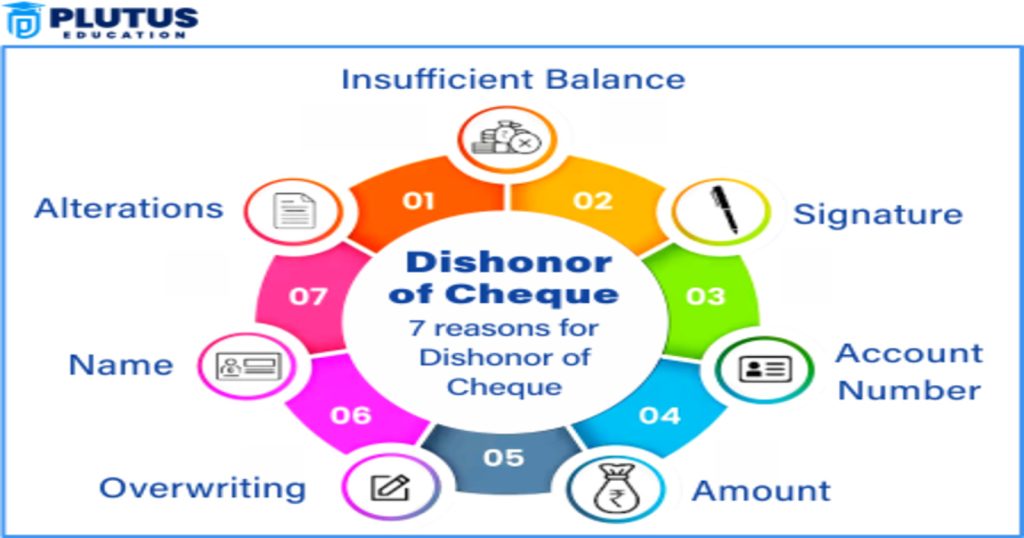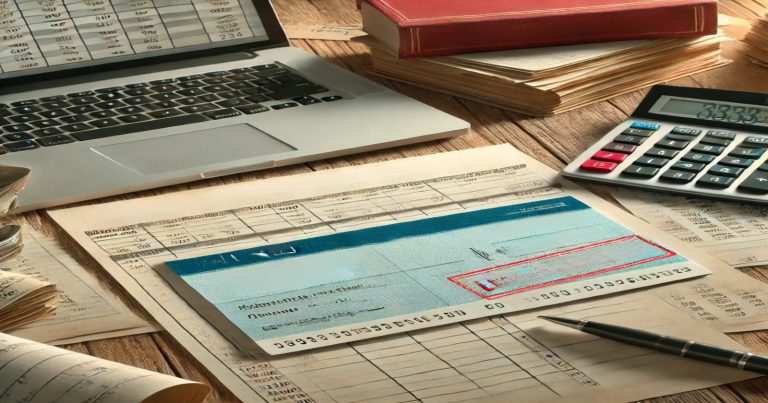In case of a bounced cheque, you need to record it correctly in your books. The entry you pass for this is called cheque dishonoured journal entry. This journal entry shows that the money that you have expected to receive or pay has not gone through yet. When you reverse the original transaction and depict that the cheque bounced you post this entry. As the name implies, it is the accounting entry that is created when bank of a cheque already received or issued is not settled due to insufficient cash or wrong signature, closed account or any other bank problems.
In this article, we will cover all about cheque dishonoured journal entry including formats for journal entry for cheque dishonoured, cheque returned dishonoured journal entry, and cases like cheque dishonour and bank charges journal entry. We will also discuss various scenarios regarding cheque received, cheque issued, and cheque deposited.
What is a Cheque Dishonour?
Cheques are deemed as dishonoured when the bank refuses to clear it. Similarly, it can happen in either case — when it is received by you and even when you are issuing it to someone else. You will have to do the reversal of the earlier entry to indicate that the cheque bounced.
Some of the common reasons for cheque bouncing are as follows:
- Not enough funds in the drawer’s account
- Signature mismatch
- Cheque old (more than 3 months)
- Overwriting or tampering
- Account closed or blocked
- Stop payment instruction
In any these cases, the bank returns the cheque unpaid. You know this through your bank statement or bank intimation.
Cheque Dishonoured Journal Entry Importance

To update your books correctly, you have to do this journal entry. And, without noting it down, your bank balance could appear inflated. You also cannot get the money back or balance accounts.
Why is it important?
- Keeps bank balance accurate
- Assists in monitoring/reconciling receivables/payables
- Prevents audit errors
- Represents true financial condition
- Data keeps changing, and the larger challenge is actually trust and control in accounting.
Journal Entry for Check Dishonored: When You Receive a Cheque
In normal circumstance you would debit bank and credit customer (debtors) account when you are receiving cheque from the customer. But what you do is, if the cheque bounces, you reverse this, you reverse this transaction.
Entry Format:
| Particulars | Debit ₹ | Credit₹ |
| Debtor’s A/cTo Bank A/c | ₹X | ₹X |
In the journal for cheque received dishonoured journal entry, this is the journal entry for cheque dishonoured.
Example:
Mr. Arun pays you ₹15,000 by cheque. You record:
Bank A/c Dr ₹15,000
To Arun A/c ₹15,000
Later, the cheque bounces. Then cheque dishonoured journal entry now as follows:
Arun A/c Dr ₹15,000
To Bank A/c ₹15,000
This entry voids the previous receipt.
Journal Entry for Cheque Bounced by Bank – With Bank Charges
The bank may also levy a penalty if the cheque bounces. You need to post the reversal of the cheque and the bank charge.
Entry Format:
| Particulars | Debit ₹ | Credit₹ |
| Debtor’s A/cBank Charges A/cTo Bank A/c | ₹X₹Y | ₹X+Y |
This is the cheque dishonour and bank charges journal entry
Example:
Mr. Vivek gives you ₹20,000 by cheque. It gets bounced, and the bank deducts ₹200. You pass:
Vivek A/c Dr ₹20,000
Bank Charges A/c Dr ₹200
To Bank A/c ₹20,200
You enter this to record both the returned receipt and the expense of bank charges.
Cheque Returned Dishonoured Entry – Different Cases
You may either accept or provide a cheque. In both cases, if it does not get paid, a journal entry needs to be passed. In each case the entry is different.
We can examine both scenarios.
Case 1: Cheque Received Dishonoured
| Date | Particulars | Debit ₹ | Credit₹ |
| Date of Receipt Dishonour Date | Bank A/cTo Debtor A/c Debtor A/c To Bank A/c | ₹X ₹X | ₹X ₹X |
This is the journal entry for cheque received dishonoured journal entry.
Case 2: Cheque Issued is Dishonoured
You write a cheque out to a creditor. The entry when issued is:
| Particulars | Debit ₹ | Credit₹ |
| Creditor’s A/cTo Bank A/c | ₹X | ₹X |
You will have to reverse the entry if the cheque bounces:
| Particulars | Debit ₹ | Credit₹ |
| Bank A/cTo Creditor’s A/c | ₹X | ₹X |
This is the cheque issued dishonoured journal entry.
Case 3: Dishonoured Cheque after Deposit
This is similar to case 1. You get a cheque, and it bounces. Debit bank, then reverse it.
Initial Entry:
Bank A/c Dr ₹X
To Debtor A/c ₹X
Dishonour Entry:
Debtor A/c Dr ₹X
To Bank A/c ₹X
This entry is for cheque deposited dishonoured journal entry.
Journal Entry for Dishonour of Cheque with Commission
In some cases, the bank will also remove not only a tax but also a commission. In this scenario, both need to be recorded on their own.
Entry Format:
| Particulars | Debit ₹ | Credit₹ |
| Debtor’s A/cBank Commission A/cTo Bank A/c | ₹X₹Y | ₹X +Y |
Example:
You receive ₹5,000 by cheque. The cheque bounces. The charges of the Bank include ₹100 as penalty and ₹50 as commission. Then the entry is:
Customer A/c Dr ₹5,000
Bank Charges A/c Dr ₹100
Bank Commission A/c Dr ₹50
To Bank A/c ₹5,150
This entry keeps your records clean and lists all charges correctly.
Common Mistakes to Avoid While Entering Journal Entry for Cheque Dishonoured
If you are a student or a beginner, some mistakes you will do. Here’s what you should avoid:
- And remember to also reverse the original transaction
- You have to reverse the bank entry correctly.
- Do not use wrong account name
- Input entry specific to the customer/creditor name
- Do not miss the bank charges
- Keep track of penalty or the fee charged by the bank.
- Avoid using cash account
- A dishonoured cheque doesn’t touch cash, only bank.
How This Entry Impacts Financial Statements
- It reduces bank balance
- So it boosts receivables (in case cheque received fails)
- It leads to higher payables (when issued cheque disappears)
- It adds extra costs (if there are bank fees)
This entry should always be updated before finalizing any books or preparing a balance sheet.
Relevance to ACCA Syllabus
In ACCA, this is part of Financial Accounting (FA) and Financial Reporting (FR). Accounting students need to know double-entry principles and how to account for reversals, such as bounced cheques. It relates to tested exam topics like bank reconciliations and suspense accounts.
Cheque Dishonoured Journal Entry ACCA Questions
Q1: How to write the journal in case the cheque received from a customer is dishonoured?
We have learned a lot in this process.
B. Customer A/c Dr. Bank A/c
C. Bank A/c Dr; To Sales A/c
D. Sales A/c Dr; To Bank A/c
Answer: B
Q2: What is the consequence of not recording dishonoured cheque?
A. Debtors are understated
B. Bank balance is over recognised
C. Revenue is overstated
D. Cash is overstated
Answer: B
Q3: How is entry passed to this dishonour of cheque in books if bank has charged ₹100?
A. Debit Bank A/c
B. Debit Bank Charges A/c
C. Credit Bank Charges A/c
D. No entry is needed
Answer: B
Q4: Accounts that are involved in a Cheque dishonour journal entry?
A. Bank and Sales
B. Cash and Debtor
C. Debtor and Bank
D. Creditors and Cash
Answer: C
Q5: In which book dishonour of cheque is generally reversed?
A. Purchase book
B. Sales book
C. Journal proper
D. Petty cash book
Answer: C
Relevance to US CMA Syllabus
It is part of the Financial Reporting and Internal Control topic in CMA Part 1. Recognition of dishonoured cheque entries helps maintain accurate cash records and identify mismatches during cash reconciliation. It also dovetails into performance management, as it shows actual receivables and cash balances.
Cheque Dishonoured Journal Entry US CMA Questions
Q1: When a received cheque is dishonoured which account is credited?
A. Bank
B. Sales
C. Debtors
D. Capital
Answer: C
Q2: Which of the following is most directly affected by a dishonoured cheque?
A. Sales
B. Cash
C. Accounts Receivable
D. Fixed Assets
Answer: C
Q3: How to show dishonoured cheque in cash flow statement?
A. Financing activities
B. Investing activities
C. Operating activities
D. Supplemental schedule
Answer: C
Q4: In which financial statement the effect of dishonoured cheque is shown?
A. Balance Sheet
B. Notes to accounts
C. Statement of Equity
D. Depreciation Schedule
Answer: A
Q5: If there is a charge of ₹200 for dishonoured cheque by bank, the journal entry would be
A. Debit Commission Income
B. Debit Bank Charges
C. Credit Debtor A/c
D. Debit Bank A/c
Answer: B
Relevance to US CPA Syllabus
Paying cheque in CPA FAR (Financial Accounting) CPA FAR (Financial Accounting and Reporting) CPA FAR (Financial Accounting and Reporting) cheque dishonour entries proper bank reconciliation adjustment journal entries and audit trail This principle is crucial for maintaining precise financial records and aids in adherence to accounting standards, such as ASC 305, pertaining to cash.
Cheque Dishonoured Journal Entry US CPA Questions
Q1: Which journal entry would be correct if a customer returned a $1,000 cheque?
A. Bank A/c Dr $1,000
B. Customer A/c Dr $1,000
C. Sales A/c Dr $1,000
D. No entry is needed
Answer: B
Q2: In which part of the bank reconciliation are dishonoured cheques recorded?
A. Outstanding deposits
B. Errors
C. Subtracted from a bank statement
D. Enero. Book balance deducted
Answer: D
Q3: Which account has a bank fee on cheque dishonour?
A. Liability
B. Revenue
C. Expense
D. Asset
Answer: C
Q4: An unrecorded dishonoured cheque is discovered by a CPA. What should they do first?
A. Inform the customer
B. Adjust cash account
C. Ignore if it’s minor
D. Delay entry till month-end
Answer: B
Q5: What If a Dishonoured Cheque Is Not Reflected In The Financial Statements?
A. Cash is understated
B. Receivables are understated.
C. Bank is overstated
D. Sales are overstated
Answer: C
Relevance to CFA Syllabus
At CFA Level I, knowledge of dishonoured cheques is useful for doing financial analysis and evaluating working capital management. When making adjustments to cash flows, evaluating the sequence of operating results, and assessing credit risks in receivables, this is useful.”
Cheque Dishonoured Journal Entry CFA Questions
Q1: Which ratio is affected by a dishonoured cheque from a customer?
A. Debt-to-equity
B. Quick ratio
C. Return on equity
D. Earnings per share
Answer: B
Q2: How does a dishonoured cheque affect working capital?
A. Reduces current assets and liabilities
B. Increases liabilities only
C. Ramps up receivables, deflates cash
D. No impact
Answer: C
Q3: Where do you indicate dishonoured cheque charges in the financial reporting?
A. Non-operating income
B. Financing cost
C. Administrative expense
D. Deferred item
Answer: C
Q4: The analyst must do the following when a cheque is dishonoured.
Adjust the income statement
B. Revalue inventory
C. Reclassifying the cash and receivable balances
D. Modify equity reserves
Answer: C
Q5: What part of cash flow is affected by cheque dishonour?
A. Investing
B. Operating
C. Financing
D. Retained earnings
Answer: B


